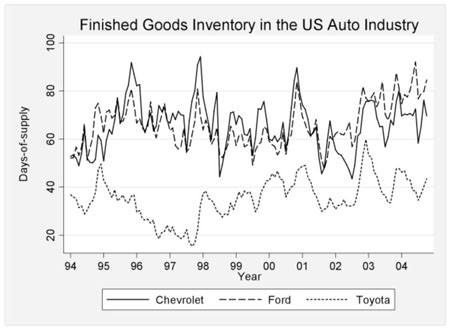
How Closing Car Dealerships Will Help the Auto Industry.

With at least 2,000 car dealerships from Chrysler and GM slated to close this year (and more than 1,000 dealerships overall that closed last year), the existing American dealership model is in crisis. The closings appear to underscore just how over-extended — and over-stocked — the U.S. dealership system has become. One of the fatal flaws for dealerships has been an inefficient distribution network.
My research, conducted with my colleague Gérard Cachon at The Wharton School at the University of Pennsylvania, shows that the current structure of the U.S. brands’ dealership network led to inefficiencies in the distribution system. These inefficiencies add to the total distribution cost, which accounts for 30% of the price of a new car.
A major inefficiency is the pattern of holding inventory — an important part of the distribution cost. Most of the vehicles in the U.S. are purchased directly from dealer stock and holding inventory is expensive, especially when credit is scarce as it is now. The graph below illustrates important differences in the monthly days-of-supply for Chevrolet, Ford and Toyota.

The popular press suggests that 60-day supply is the ideal level of inventory for the auto industry. This is, in fact, the industry average, but the figures show that Toyota is consistently below that benchmark while Chevrolet and Ford are usually above it (other brands of Ford and GM also show a similar pattern). Overall from 2000 to 2004, Chevrolet held about 130,000 more vehicles in inventory relative to Toyota (300,000 compared to 170,000 units), even though the two brands sold about the same number of vehicles in the U.S.
The huge number of GM dealerships explains most of this difference in inventory performance. As of 2007, Chevrolet had around 4,000 dealerships compared to 1,200 Toyota dealerships. That means that an average Toyota dealership sells three times as many vehicles.
| Auto brand | No. of dealerships | Sales per dealership |
| Chevrolet | 4,063 | 586 |
| Ford | 3,711 | 645 |
| Honda | 1,019 | 1,286 |
| Toyota | 1,224 | 1,821 |
Source: Automotive News 2007 Yearbook
Due to economies of scale, managing inventory for a Chevrolet dealership is much more costly than for Toyota. In general, dealerships from domestic manufacturers carry substantially more days of supply. Consequently, they require more cash to operate, their inventory is less fresh and they tend to have more overstock at the end of the model year, which in turn leads to more rebates. All of this translates into higher distribution costs and lower profits for the dealer.
How could U.S. auto dealerships be improved? Reducing the number of dealerships can do several things.
First, it will reduce cannibalization between dealerships, increasing average sales per dealership. Dealers can take advantage of economies of scale in the distribution process and have more frequent deliveries and lower safety stocks, thereby reducing the amount of inventory held without hurting (and possibly improving) customer service. It also helps to keep a fresher stock to better match customer preferences and to lower markdowns at the end of the season.
All of this leads to a more profitable dealership and a more efficient distribution network. Higher dealership earnings can be used to invest in better showrooms and better training of the sales force, which can improve customer service and further boost revenues.
Marcelo Olivares, Public Offering Columbia Business School, Julio 2009.
Ver artículo http://www4.gsb.columbia.edu/publicoffering/post/731370/How+Closing+Car+Dealerships+Will+Help+the+Auto+Industry



